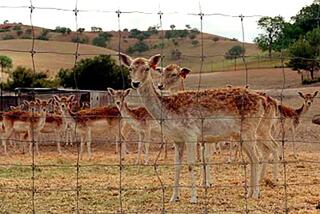These Endangered Mice Will Have It Nice
The last time federal wildlife biologists tried to gauge the Pacific pocket mouse population at the Dana Point Headlands, they counted only six of the endangered rodents. However, more than 24 acres of ocean-view real estate--worth $30 million--is being set aside for their protection.
The mouse preserve is an important issue in a developer’s attempt to create 125 lots for custom ocean-view homes, a 65-room seaside inn and commercial development on the 121-acre property. Property rights advocates question preserving so much valuable land for so few animals.
“That doesn’t make much sense,” said Laer Pearce, spokesman for the Building Industry Assn. of Southern California. “Doesn’t it seem like moving them is a much more logical option than preserving that much land for them?”
The construction project has received local approval, as well as permits from state and federal wildlife officials. However, Headlands Reserve LLC still must pass muster with the California Coastal Commission, a powerful state agency that has stalled and modified many projects along Orange County’s coast.
“This mouse basically is going to be living on a nicer lot than me,” said developer Sanford Edward, who plans to build a home for himself on the Headlands.
Still, Edward says he’s willing to sacrifice the land to get quick approval for his project.
“Even though we’re doing it for the habitat and the mouse, we recognize that the headlands portion of the property has become a landmark in and of itself,” he said. “So we’ve been willing to consider relinquishing our development rights ... in hopes that we will be able to move forward in a timely fashion.”
Little is known about the Pacific pocket mouse, a small, silky mammal with fur-lined cheek pouches that was listed as endangered in 1994. Its historic range--sandy land no more than two miles from the coast--stretched from Marina del Rey to the Tijuana Estuary, but the burrowing mouse is now known to exist in only three places. In addition to the six mice counted on the Headlands, they are found at two spots on Camp Pendleton--about 50 mice live along the San Mateo Creek, and up to 1,000 mice dwell north of the Santa Margarita River.
Environmentalists argue that for the species to recover, it’s necessary to save as much of their habitat as possible.
“They’ve been there for a long time and they’ve survived a lot of neglect,” said Dan Silver, coordinator of the Endangered Habitats League. “Hopefully, with proper management, they will rebound. We look upon it as vital. There are so few of these animals left that you have to keep every one of these places going.”
Wildlife officials say the population at the Headlands is up for debate. They counted six in 2000, but the number could be higher, said Will Miller, a biologist in the U.S. Fish and Wildlife Service’s Carlsbad office.
“I wouldn’t say that’s an accurate estimate of the population,” he said, “but the numbers are low.... We don’t know enough about [the species] to know definitively if the population is doomed or not.”
The population is small enough, though, that the mice could be inbreeding, a threat to their future health. Once homeowners move in, pets could prey on the rodents.
“Domestic cats ... are extremely efficient predators, as I think anyone that’s had a pet can testify to in terms of them bringing home local songbirds,” Miller said.
Nor is life necessarily safe for the other two populations. The proposed Foothill South toll road may run near the creek and military training exercises take place at the Marine Corps base.
Permanent conservation of the 24 acres at the Headlands is a step in the right direction and fits with the recovery plan for the species, Miller said.
Conservationists point to other animals brought back from far lower numbers. The Przewalski’s horse was down to 12 individuals, all in captivity. Now there are 1,200 of the wild horses, many of which are thriving in their native Mongolia.
That’s why environmentalists have petitioned the federal government to protect the three mouse habitats, as well as 13 unoccupied swaths of land in Orange and San Diego counties that could support new mouse populations.
Miller said the service has been looking at areas where it could establish pocket mouse populations.
Edward said such moves are key to the species recovery. Otherwise, he said, isolated populations, such as the mice at the Headlands, might not survive.



